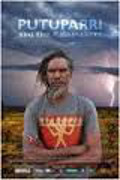
Directed by
Nicole Ma
97 minutes
Rated PG
Reviewed by
Sharon Hurst

Putuparri And The Rainmakers
Synopsis: Tom Lawford is a Wangkajunga man from the Kimberley region known as Putuparri to his people. Over a period of about 14 years we follow Tom on his several journeys from his home town of Fitzroy Crossing to his traditional lands in the Great Sandy Desert. There he finds a waterhole known as Kurtal, sacred to his people and long protected by its guardian, an old man called Spider, who happens to be one of Tom’s grandfathers.
Accompanying Tom on his rambling journeys as a viewer is at once a great privilege and also at times frustrating. There is so much to see and absorb, and yet the film’s disparate styles, combined with the difficulty at times in understanding what is being said (when subtitles are not used) makes the film a bit of a challenge.
Hot on the heels of Another Country, Nicole Ma’s documentary comes across as a more complex but less polished account of the modern indigenous experience. As with Gulpilil’s narration in Another Country, Tom’s story is also one of how the white man destroyed the sacred lands, this time by creating the Canning Stock Route and stealing access to the water holes. Interspersed with this history is a densely packed narrative of Tom’s personal journey involving alcohol and family violence. Tom introduces us to Spider and his wife Dolly, now a much-lauded painter, and also talks at length about the communal creation of a stunning giant painting, known as the Ngurrara Canvas which was used to help gain recognition of native title on the Kurtal lands many years later. Interwoven into the story is the issue of the younger generations having to accept the mantle of guardianship of the sacred places and learning the tribal lore and culture.
The film covers four journeys made to the sacred waterhole. Because the first journey to Kurtal takes place in 1994, the only footage is from an old video camera used by Tom and is, unsurprisingly, crude. In other segments at the waterhole, the most rewarding footage involves seeing the old folk singing and wading into the waters and digging up rich mud with which to smear their bodies. It is the sort of ritual we as white folks are unlikely to ever witness in real life.
As a contrast to the sometimes old and grainy footage, there are scenes of exceptional beauty – brilliant cinematography captures vibrant desert sunsets, flocks of vivid galahs, lightning storms piercing the skies, and inspirational scenes of the locals dressing up to dance in flamboyant yellow head-dresses and richly colourful body paint.
Many of the themes raised and the history covered would be enough for individual films in their own right: Tom’s personal story, tellingly commented upon by one of his daughters, and his sister, Ningali (recently seen starring in Last Cab to Darwin); the story of the community creating the vibrant and magnificent Ngurrara Canvas; and the history and lore of Aboriginal culture. But these elements simply don’t get the time they deserve. The attempt to pack them all into one standard length film seems almost too ambitious and makes for an oddly disjointed viewing experience.
On the other hand, simply having put it all together and giving us a rare insight into a way of life under threat is a feat in itself and makes for fascinating, and important viewing.

Want more about this film?


Want something different?




